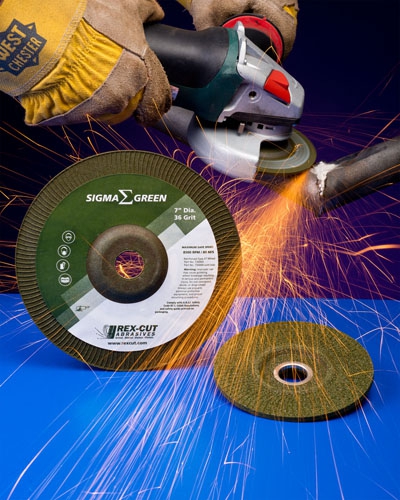
A line of abrasive grinding wheels that grind fast to reduce discoloration and warpage on stainless steel while eliminating chatter is available from Rex-Cut Abrasives.
Rex-Cut Sigma Green Premium grinding wheels feature proprietary construction, which provides rapid stock removal and leaves a nice finish; especially on 304 stainless steel where these 36 grit discs produce a 100 Ra finish. Featuring smooth, chatter-free performance to help reduce operator fatigue, these grinding wheels are available in 4", 4-½", 5" and 7" sizes, with and without hubs, and optional 5⁄8-11 throw-away adapters.
Virtually iron-free, Rex-Cut Sigma Green Premium grinding wheels contain only 0.035 percent iron, with less than 0.1 percent or iron, chlorine, and sulfur combined. Designed for use with right angle grinders, they provide 50 percent faster cutting than aluminum oxide and 20 percent cooler cutting, claims the firm. The 4-½" wheel is also offered in 46- and 60-grit versions.
Contact Details
Related Glossary Terms
- abrasive
abrasive
Substance used for grinding, honing, lapping, superfinishing and polishing. Examples include garnet, emery, corundum, silicon carbide, cubic boron nitride and diamond in various grit sizes.
- aluminum oxide
aluminum oxide
Aluminum oxide, also known as corundum, is used in grinding wheels. The chemical formula is Al2O3. Aluminum oxide is the base for ceramics, which are used in cutting tools for high-speed machining with light chip removal. Aluminum oxide is widely used as coating material applied to carbide substrates by chemical vapor deposition. Coated carbide inserts with Al2O3 layers withstand high cutting speeds, as well as abrasive and crater wear.
- chatter
chatter
Condition of vibration involving the machine, workpiece and cutting tool. Once this condition arises, it is often self-sustaining until the problem is corrected. Chatter can be identified when lines or grooves appear at regular intervals in the workpiece. These lines or grooves are caused by the teeth of the cutter as they vibrate in and out of the workpiece and their spacing depends on the frequency of vibration.
- fatigue
fatigue
Phenomenon leading to fracture under repeated or fluctuating stresses having a maximum value less than the tensile strength of the material. Fatigue fractures are progressive, beginning as minute cracks that grow under the action of the fluctuating stress.
- grinding
grinding
Machining operation in which material is removed from the workpiece by a powered abrasive wheel, stone, belt, paste, sheet, compound, slurry, etc. Takes various forms: surface grinding (creates flat and/or squared surfaces); cylindrical grinding (for external cylindrical and tapered shapes, fillets, undercuts, etc.); centerless grinding; chamfering; thread and form grinding; tool and cutter grinding; offhand grinding; lapping and polishing (grinding with extremely fine grits to create ultrasmooth surfaces); honing; and disc grinding.






